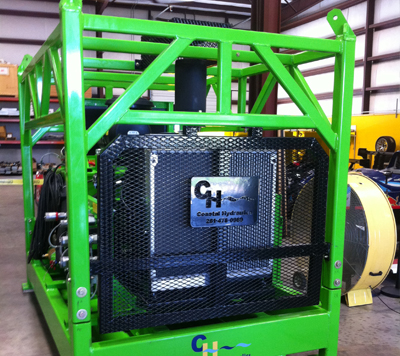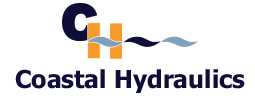Design and Build
With years of experience in the industry, Coastal Hydraulics is able to design and build custom systems to match your applications. This can be anything from a custom cylinder to a complete hydraulic system.
Good hydraulic power unit design requires:
ReservoirTank volume sized for 5 to 8 times pump flow allowing fluid to settle in tank but re-circulate enough for stable temperature and keep clean. Actuator drain down and working volume changes must also be taken into account.
Baffle Plate
Separates return and supply lines allowing dirt and air to settle before reuse.
Tank Access Cover
Securely closed tank, designed so users cannot leave open. Used for maintenance access and cleaning only.
Air Breather
Allows fluid volume in reservoir to change and filters air movement. If filling through the breather then new fluid should be pumped through a separate filter.
Suction Line
Large diameter, short pipe for low fluid velocity. Pumps should have a positive head or be primed before first start. Often flexible pipe to isolate pump vibration from tank.
Suction Filter
Can improve supply conditions but dangerous if not maintained as they can restrict pump supply.
Pump
Fixed or variable displacement pump supplies flow to circuit. Typically gear, vane or piston design depending on budget and performance. Isolate with rubber mountings to reduce noise.
Case Drain Line
Some pumps require case drain lines which must be adequately sized and primed with fluid before initial start up.
Bell Housing and Coupling
A flexible drive coupling is required between the pump and motor to accommodate any misalignment or vibration. With some pumps the pump drive shafts move slightly with pressure so rigid location is not permitted.
Electric Motor
Sized for maximum pump input power plus say 15% safety margin.
Immersion Heaters
Fluid immersion heaters often have built in thermostats to ensure the fluid stays above its minimum working temperature. This may be required before starting the pumps.
Cooler
Return line or offline coolers prevent the tank temperature going above the design limits of the system.
Temperature Switch
Temperature warning and cut-out switches can be provided to ensure the system does not work outside its design limits.

Pressure Hose
Short flexible hose between pump and first component in circuit. Helps reduce noise and vibration. Allow pumps to move.
Pressure Test Point or Gauge
For safety and maintenance a pressure gauge or test point are recommended.
Pressure Filter
Contamination causes over 90% of all failures. A pressure filter should stop contamination reaching components in the circuit. Include a bypass valve to stop clogging elements breaking and an indicator to say when elements need replacing.
Relief Valve
Essential to protect the system against over pressurisation and potentially dangerous failures. Also used to unload system for pump startup or standby.
Isolation Ball Valve
Protect worker during maintenance and stop siphoning of fluid when items are changed or removed. Often lockable for extra security.
Filling Point
Pump new fluid into the reservoir through the return line filter to ensure it's clean.
Return Line Filter
Ideal for cleaning recirculated fluid. Bypass protects clogged filters from failing and visual or electrical indicators warn when elements need changing.
Anti Siphon Valve
Stops the backflow of fluid when valves in the circuit are removed for maintenance. Sometimes small holes are drilled above the fluid level inside the reservoir to break the siphon or screw fittings are provided to allow air breaks to be made.
Sight Level Gauge
Sight level gauges show the volume of fluid in the reservoir and are good early indicators of problems or leakage.
Level Switch
Level switches should remote visual warnings of low fluid and pump cut-out with very low fluid level. High fluid level warnings are also provided sometimes.




